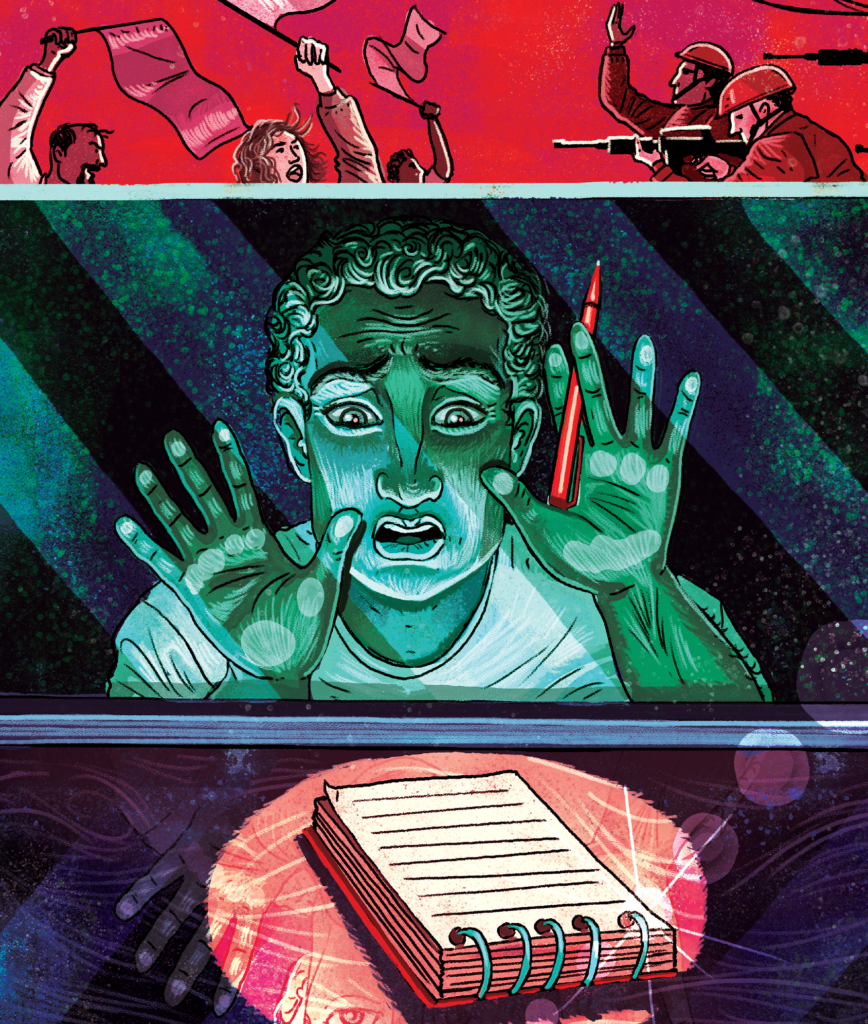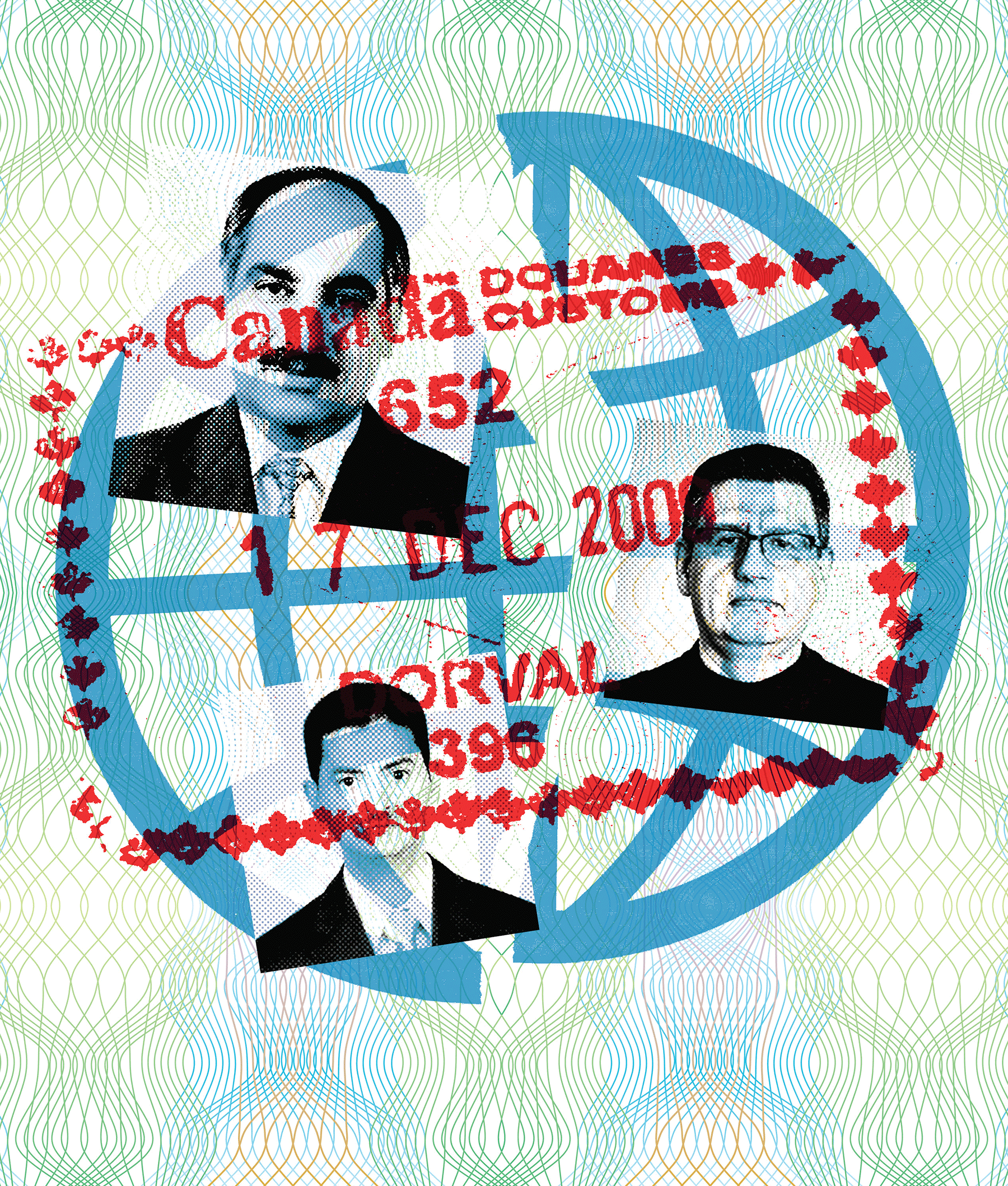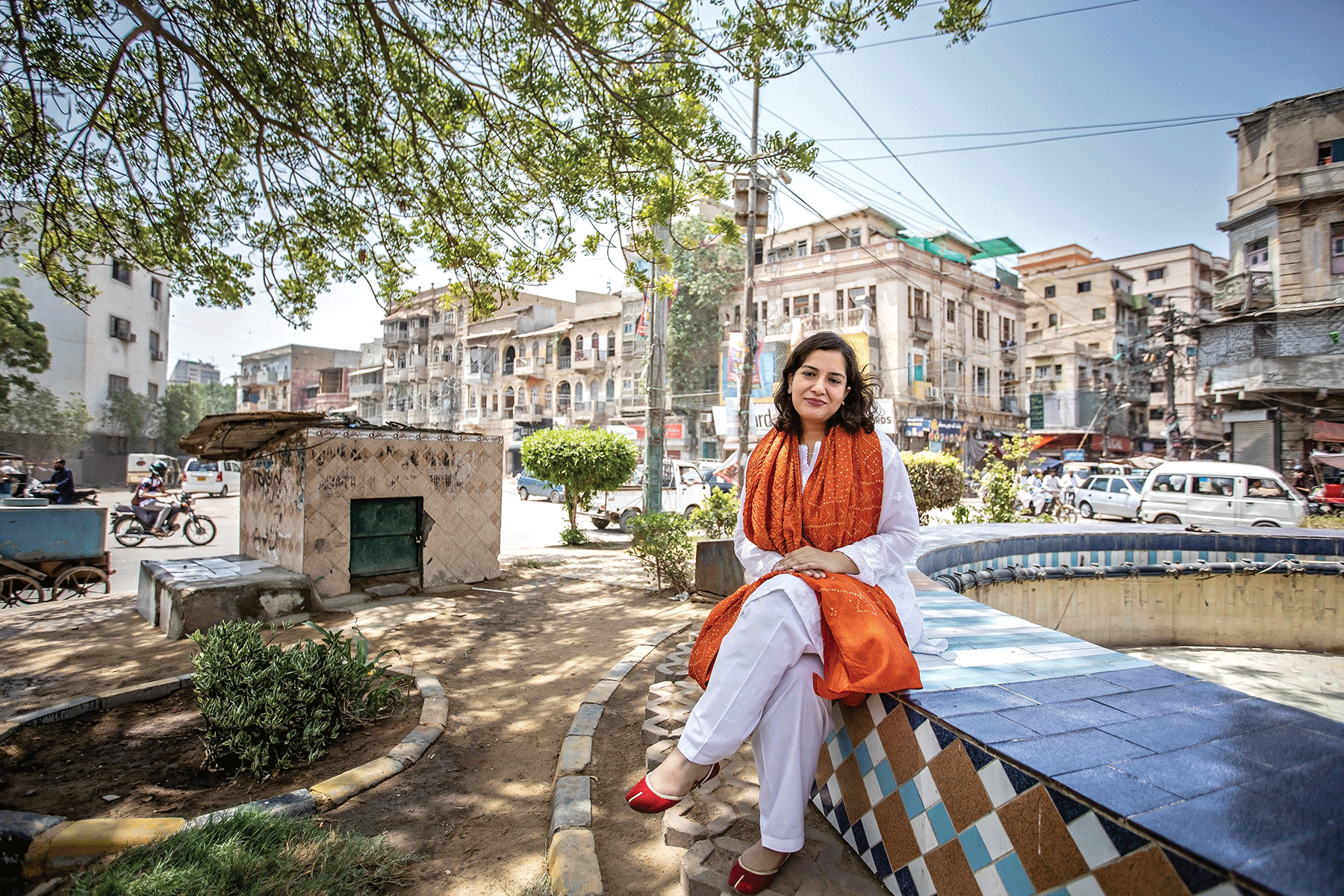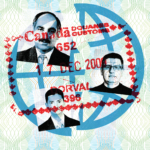Non-profits are urging Canada to facilitate refuge for journalists in danger, but can the industry help them get back to work?
Abdulrahman Matar couldn’t wait any longer. When his friends in New York urged him to stay with them for a few extra days so he could get some rest before travelling on to Canada and exile, he resisted, even though he had obtained a U.S. visitor visa. “When I got the visa,” Matar explains, “somebody [told] me, ‘Yeah, you get the visa, but that does not mean you will enter the U.S.’” Matar is a writer and journalist from Syria, but by February 2015 he had already travelled from his temporary place of refuge in Saudi Arabia to Turkey to New York City.
He had spent the 10-hour plane ride from Turkey to New York with his stomach in knots, unsure if he would be sent back as soon as he landed. His nervousness was overwhelming when he arrived at John F. Kennedy International Airport, and he soon came face-to-face with a U.S. border agent, who asked him a series of questions. “I am so high anxiety that maybe they will retain me,” Matar remembers thinking. “After that, in two minutes, maybe three minutes, in the airport they said, ‘Welcome.’”
Matar had been arrested four times, detained, threatened with violence, and beaten by Syrian officials for his work as a journalist. His “crimes” included publishing critical analyses of the Syrian government and President Bashar Al-Assad’s administration, especially their handling of the pro-democracy protests that arose in Syria during the Arab Spring. These initial protests led to Syria’s ongoing civil war, which has resulted in approximately 593,000 deaths and 13 million displaced Syrians worldwide, according to a 2020 report from the Syrian Observatory for Human Rights.
“[You] can’t write anything [you] want in their newspaper because of government control, because of government censorship; intelligence agencies make sure of this,” says Matar. Still, he continued, until his fourth arrest, in June 2012. He had gone back to his home in Damascus, where a neighbour said, “Someone is looking for you.” Matar knew he couldn’t stay in Syria any longer, and he crossed the northern Syrian border into Turkey with the help of a double-agent government official.
The threats continued.
Matar made regular TV appearances while trying to continue working as a journalist after settling in Istanbul. During this time, his name was added to a blacklist compiled by ISIS, which exacerbated the threats against his life, even though he had fled Syria. “That’s a big problem for the government when I talk—me and other Syrian writers talk about [the] government, and about the ISIS and radical movement,” he says. “They want me to keep silent.” Strangers sent him threats over Facebook, saying things like “We know everything about you, where you live, what you eat, where you go,” he recalls.
On the final leg of his journey in 2015, a friend drove him across the Peace Bridge that binds Buffalo, N.Y., and Fort Erie, Ont. In the early morning hours, the two approached the Canada Border Services Agency. His friend would hand over his American passport to the border guard, and, when an officer asked for Matar’s documents, he would say he had none.
Matar was asked to come inside the border offices and hand over every shred of documentation he had. The officer offered him coffee and an apple, then proceeded to question him for five hours, with breaks to eat or get coffee. Matar took solace in the fact he had nothing to hide. “I have a true story, and I have trust [in] myself,” he says.
But Matar has been interrogated by Syrian intelligence agents, who were prone to use physical force. After hours of firm, non-violent questioning by the Canadian agent, he found the stress impossible to manage. “I [told] the interpreter that I can’t continue. Please tell her I want to stop. I don’t need to enter Canada.” He was told to relax and go to the “living room.” He sat down in a room full of couches seating clusters of families. He was so tired his eyes were bloodshot, and he did not think to read the document an officer held out in front of him. “I [was] very sure they’ll refuse me,” Matar says. “She says, Sign. I sign. I don’t know what about.”
He quickly found out. As soon as he could focus on the others in the room, he noticed that “all the people, they looked at me with a smile.” The strangers came up to him and congratulated him, explaining that he had just signed his landing papers and that he had been accepted into Canada. When Matar finally understood what was going on, he began to cry.
He left the Canada Border Services Agency office the day he arrived, as the winter sunset was approaching, into the cold, clear air. He’d had the foresight to bring a jacket along. That night, he had his first good sleep in 15 years: “I am under Canadian [protection], I am at peace, and I can be free.”
Over five years after Matar crossed the border into Canada, the International Bar Association’s Virtually Together conference took place, in November 2020. The High Level Panel of Legal Experts on Media Freedom, a group of international lawyers and media freedom experts, chaired by Lord David Neuberger of Abbotsbury and deputy chaired by barrister Amal Clooney, who originally convened at the request of Canada and the United Kingdom, presented the findings of one of their reports through a special web broadcast. The “Report on Providing Safe Refuge to Journalists at Risk” recommended that member countries of the Media Freedom Coalition—a partnership of 46 nations aligned to uphold media freedom and to maintain the safety of journalists and media personnel—must create emergency visas for journalists experiencing threats of violence, imprisonment, and death. “Sometimes obtaining a visa to go abroad is the only way to keep a journalist safe or keep them alive,” Clooney said in her remarks. An expedited escape for at-risk journalists is urgently necessary to combat injustices against press freedom, according to the panel.
As a co-founder of the coalition, Canada should take an interest in advancing its leadership role, says Committee to Protect Journalists advocacy director Dr. Courtney Radsch, who sits on the advisory network to the panel. Due to the “dearth of leadership on the international stage,” Dr. Radsch believes Canada is equipped to make meaningful policy changes that would improve the welfare of journalists under threat. According to the CPJ, the number of journalists who were murdered for their work more than doubled in 2020, from 10 the previous year to 22.
Canadian Journalists for Free Expression (CJFE) is a non-profit organization that defends access to information and press freedom globally and within Canada. The COVID-19 pandemic exacerbated the inhuman treatment of journalists and the suppression of press freedom worldwide. Due to these ongoing pressures on journalists, on December 10, 2020, the CJFE called on the federal government to allow 100 at-risk journalists into Canada annually. The request was signed by 19 organizations and individuals, including PEN Canada, the Canadian Journalism Forum on Violence and Trauma, the CPJ, Journalists for Human Rights, and four Nobel laureates.
The campaign was spearheaded by Michelle Shephard, who leads the CJFE’s International Issues Committee. “There’s so many journalists right now facing hardships or with their lives at risk,” says Shephard. “And for many of them Canada tends to be a top destination.”
Shephard is a well-known investigative journalist who used to be a foreign correspondent for the Toronto Star and now co-runs her own documentary film company. In her extensive work for the Star, Shephard relied on local journalists. These individuals helped in “immeasurable ways,” she says, providing assistance with transportation, security, and translation, and sharing invaluable cultural context. A local journalist named Khaled Al-Hammadi helped her out of a compromised situation during a Yemeni protest in 2011. “I got on the wrong side of the government troops and was hiding somewhere,” says Shephard. “Khaled actually came out and helped me get to safety.” The two have known each other since 2009, which is when they first worked together.
Al-Hammadi was forced to flee Yemen after his non-profit organization—the Freedom Foundation—was threatened with destruction by militia groups. “They [said they would] blow up the office of our NGO if we didn’t stop writing about war violations or abuses,” he says. He briefly lived in Turkey before emigrating to Canada in January 2018. He is still waiting for his wife and children to be reunited with him. Al-Hammadi was informed the Canadian immigration approval process would take approximately 23 months, yet he learned in December 2020 that his family’s case would take longer.
“He managed to come here on his own. He’s a brilliant guy, but this would have been a perfect case had this fast-track program [existed then]. What if we could have helped him right away?” says Shephard. “It took him a long time to get to Canada and he’s one of the lucky ones who did. You know, most journalists in distress never make it here.”
Al-Hammadi is now living in Ottawa after completing his master’s degree in digital media at Ryerson University in Toronto. He had applied for a PhD at Carleton University in Ottawa and moved from Toronto without receiving the university’s response. “I visited the Rideau Canal, skating, and wow, it’s amazing,” he says. “I like it here despite, you know, usually winter is very hard for me. But when I saw this canal, I loved it.”
“It took him a long time to get to Canada and he’s one of the lucky ones. Most journalists in distress never make it here”
“The good thing is [the] CJFE is a strong organization with strong people committed to help journalists around the world,” says Morteza Abdolalian, who has been a board member at the CJFE since 2002, and currently sits on the International Issues Committee. A journalist and human rights advocate, he was forced to flee Iran due to the nature of his work. Abdolalian also tracks human rights violations at his site, Iran Watch Canada. For example, on an ongoing basis he was in contact with about a dozen journalists who had recently escaped repression in Iran and were living as refugees in Turkey. They hope the CJFE can help them come to Canada. “I don’t want to forget these journalists…they email me constantly,” says Abdolalian. “We have a moral obligation to help these journalists, to support this initiative, to ask the government of Canada to respond to CJFE, to take this action seriously.”
The CJFE board members are optimistic about the campaign, which appears “modest in the grand scale of immigration cases,” says Shephard. She says that in proportion to the issue of the threats facing journalists internationally, 100 journalists is a small number. For comparison, from January to December of 2020, the Immigration and Refugee Board of Canada accepted 16,209 claimants as refugees in need of protection. The CJFE received a response from representatives of the office of Minister of Immigration, Refugees and Citizenship, Marco Mendicino, and discussions with his policy advisers have been ongoing since early 2021.
Currently, Canada’s refugee resettlement program does not track identifying data for security and privacy reasons, nor does it track refugees’ occupations. According to a CPJ data set, Canada was once fourth on the list of major host countries, accepting 21 exiled journalists in 2007. Another CPJ report from 2009 notes that between 2001 and 2009, 18 journalists were relocated to Canada. According to data obtained from IRCC by New Canadian Media, from September 2010 to September 2020, 845 journalists were admitted into Canada under the professional immigration stream.
As part of its call to action, Shephard says the CJFE’s goal is to create space for meaningful employment in journalism for these individuals who would be coming to Canada. “Coming here is the first step,” she says. “But once they are safe, it can be so hard to continue their work.” The CJFE is in the early days of trying to organize internship programs, build media partnerships, and reinvigorate its Journalists in Distress Fund, a program founded in 1999 to help threatened journalists evacuate their hostile situations and possibly emigrate to safer countries. The network for the Journalists in Distress Fund includes 18 international organizations. From 2017 to 2019, the CJFE didn’t have the financial means to contribute to the fund. In 2020, however, the International Issues Committee, including Shephard and Reuters journalist Amran Abocar, was able to raise $10,000 from a GoFundMe campaign that was matched by Reuters.
With these new resources, part of the plan to further expand the fund is to help the Journalists in Exile group, which is composed of individuals who have come to Canada on their own or with the help of the CJFE. So as to aid those who can’t benefit from Journalists in Distress support because they are no longer living in a life-threatening situation, the CJFE is designing a new vision and action plan to help domestic members of the JEX. The CJFE is working on a plan that would grant the proposed 100 journalists access to a network of media organizations, mentors, journalism colleges and faculties, and other connections to help them get settled and back into their vocation.
For Luis Horacio Nájera, his creative process is the hardest part. He produces and hosts a Spanish current events podcast, Español: un idioma, muchas ideas. When Nájera started his show, he wanted to connect his personal experiences with issues that were universal. In an early episode entitled “Soledad” (Loneliness), Nájera discusses the gruelling solitude created by COVID-19, and how his podcast helps him cope with his isolation. Changing to a more news-focused approach in the latter half of the season, the show became more complex and research-intensive. In an episode called “Los cien fuegos del general” (The General’s Hundred Fires), Nájera provides an analysis of Mexican Defence Secretary Salvador Cienfuegos U.S. acquittal of drug trafficking and money laundering charges. The episode took him at least four days of work to produce. Money is tight, so he uses Anchor to record, edit, and add non-copyrighted music. “After the product is finished, I just take some time to enjoy a little moment of professional happiness, provoked by feeling like a journalist again, even for one hour.”
Nájera has limited space in his family’s apartment, so he produces from his bedroom desk. He has worked and studied in this spot since moving to Toronto, and now his two master’s degrees from York University are framed and hanging on the beige walls above it. Nájera poured himself into the self-produced podcast, despite only having a small number of listeners. What drags his creative process out the most is the time he spends questioning why he bothers.
Nájera’s passion for journalism has never ended, despite the hardships he and his family have gone through. Nájera came to Canada from Juárez, Mexico, and has 19 years of experience investigating and reporting on political corruption and drug cartels in the Mexican/U.S. borderlands. He was forced to leave Mexico after receiving death threats as a consequence of his reporting; some of his colleagues had already been murdered, and others were killed after he left the country. In 2008, he travelled to Vancouver to seek asylum with his wife and three children with the help of the CJFE, which was considered to be an expert witness by the immigration board. As a result, the CJFE sent in a letter that supported Nájera and his family’s refugee claim.
At a virtual event held on March 9, 2021, hosted by Massey College at the University of Toronto, a panel discussion is centred around refugee journalists’ handling of Canadian life. The event highlights a special preview of the upcoming documentary Nájera is featured in, called The Cost of Freedom—Refugee Journalists in Canada. On camera, he is wearing a crisp white button-down shirt and a suit jacket. His Zoom appearance gives off an air of distinguished formality. Nájera is honoured to be coming home to Massey College, albeit virtually.
He didn’t expect that he would be paying the price of being a refugee for as long as he has. For him, Massey College represents a point in his life in Canada where it seemed as though his journalistic career could be relaunched. In 2011, after he was named the recipient of the CJFE International Press Freedom Award, he secured the Massey College Southam Fellowship under Scotiabank-CJFE sponsorship, which covered his and his family’s relocation expenses when they moved from Vancouver to Toronto a year later. Nájera recalls Massey College and the other fellows as a community of inclusivity, which empowered him to recover his “professional dignity.”
The panel discussion includes the documentary’s director, James Cullingham, and two other exiled journalists: Abdulrahman Matar and Arzu Yildiz, who was profiled in a 2020 [ ] Review of Journalism article. When the moderator asks what they hope for the future of journalism, Nájera replies, “I stopped thinking about the future the day that I left my country.” He attests to the setbacks he has experienced in Canadian media. His name is recognizable to those in the industry because he has spent the majority of the past decade reinventing himself in order to find a place here, but to no avail. He mentions his one full-time employment stint in Canadian media—six months at Star Touch as a content editor. His temporary contract was terminated early as part of the first wave of layoffs in January 2016 at the now-scrapped Toronto Star tablet app.
“My experience dealing with media companies here in Canada as far as a person who is looking for a job, I think there’s an invisible barrier that I haven’t been able to cross,” he says.
As the event wraps up, he offers a final thought, so as to not sound ungrateful. “Since I’ve been in Canada, there’s marvelous, wonderful people here, journalists with a huge sense of solidarity,” he says. He begins rattling off names he can recite by heart: Marina Jimenez, Robert Cribb, and Michelle Shephard among them. “Unfortunately, there’s the few and there’s a system,” he says. He speaks quickly, closing with a crucial message for his community of journalists in exile. “If you look at our stories individually, they are encouraging, amazing, brave,” says Nájera. “When you put 10, 15, 20, 50, 100 stories in the context of Canada and the refugee system, those stories evaporate.”
Read More
This piece is the second in a series examining the inequities of press freedom worldwide with a Canadian lens, while also showing the hidden realities of exiled journalists in Canada. The first article, “The Afterlife”, written by Neha Chollangi, was published in Spring 2020.





